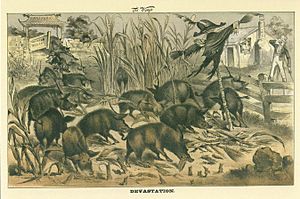Burlingame Treaty facts for kids
| Signed | July 28, 1868 |
|---|---|
| Location | Washington, D.C. |
| Signatories | |
| Language | Chinese, English |
The Burlingame Treaty (Chinese: 中美天津條約續增條約), also known as the Burlingame–Seward Treaty of 1868, was an important agreement between the United States and China. It updated an earlier treaty called the Treaty of Tientsin.
This treaty helped create friendly relations between the two countries. It also gave China "most favored nation" status for trade. This meant China would get the best trade deals the US offered to any other country. The treaty was signed in Washington, D.C. in 1868 and approved in Peking in 1869. A big part of the treaty was that it removed old rules about people moving from China to the United States. This led to many Chinese immigrants coming to the US.
How the Treaty Came About
China and the United States signed the Burlingame–Seward Treaty in 1868. It was meant to build on the Treaty of Tianjin from 1858. The new treaty set up basic rules to make immigration easier. It also showed China's wish to limit other countries from interfering in its own matters.
In 1861, Anson Burlingame became the US minister to the Qing Empire in China. Burlingame was an experienced diplomat. He chose to be cooperative and friendly with China, instead of being aggressive. He built good relationships with the reform leaders in the Qing government.
The United States also wanted to have good trading chances in China. They also hoped to continue spreading Christianity in Asia through missionaries. Western countries encouraged the Chinese government to send diplomats abroad. China finally agreed and asked Burlingame to go with their representatives. This tour included major cities like Washington, London, Paris, and Berlin. Burlingame left his job as a US representative to help China with these important talks.
While in Washington, Burlingame worked with Secretary of State William H. Seward. They negotiated a new treaty to update the 1858 Treaty of Tianjin. The first parts of the new treaty protected trade in Chinese ports and cities. They also allowed China to send consuls (officials) to American port cities.
More important parts of the treaty allowed Chinese people to freely immigrate and travel within the United States. It also promised to protect Chinese citizens in the United States. This protection followed the "most-favored-nation" rule. Another part of the treaty gave citizens of both countries access to education when living in the other country. All these points helped show that the two nations were equal.
The last part of the Burlingame–Seward Treaty offered China some protection from outside influence. The US agreed that China's local government should decide on new building projects. This was to prevent the US from getting too involved in China's internal affairs.
In 1867, Burlingame was chosen to lead a Chinese diplomatic group to the United States and Europe. This group included two Chinese ministers, two Western secretaries, and six students from Peking. They arrived in the United States in March 1868. Burlingame used his good connections with the US government to quickly negotiate a fair treaty. He gave many speeches across the country. In these speeches, he spoke strongly for treating China equally and welcoming Chinese immigrants. On July 28, 1868, the new articles were added to the 1858 Reed Treaty. These became known as the Burlingame Treaty.
What the Treaty Said
The Burlingame Treaty included several key points:
- It recognized China's full control over all its land.
- It gave China the right to send consuls to US ports. These consuls would have the same rights as those from Great Britain and Russia.
- It stated that US citizens in China and Chinese people in the US could practice their religion freely. They would not be treated badly because of their faith.
- It gave certain rights to citizens of either country living in the other. However, it specifically said they could not become citizens of that country.
Impact of the Treaty
At first, the treaty encouraged Chinese immigration to the United States. But soon, people in the US Congress began to oppose Chinese immigration. Because of this, President Rutherford B. Hayes asked James Burrill Angell to renegotiate the treaty in 1880.
On November 17, 1880, a new treaty was passed. It was called the Treaty Regulating Immigration from China, also known as the Angell Treaty of 1880. This new treaty allowed the US to temporarily stop, but not completely ban, Chinese immigration. It also confirmed that the US had to protect the rights of Chinese immigrants who were already in the country.
Even though the Burlingame Treaty offered protections to Chinese people in the US and Americans in China, it also helped US trade. It ensured a steady supply of low-cost Chinese workers for American businesses. Because of this, American business leaders first saw the treaty as a big step forward for US trade.
However, the treaty's success did not last long. By the late 1870s, US leaders could not ignore the growing anti-Chinese feelings in the United States. This was especially true in the western states. In fact, some business leaders and politicians even encouraged these anti-Chinese actions. A new treaty in 1880 changed the Burlingame–Seward agreement. Then, the Chinese Exclusion Act of 1882 completely canceled the parts of the treaty that allowed free immigration.


